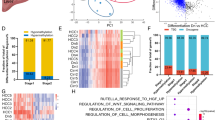Abstract
Wnt/β-catenin signaling pathway, having a crucial role in regulating diverse cellular processes, can be a new therapeutic target in cancer. To investigate the role of Dkk-1 (Dickkopf-1) and Dkk-3 in tumors and cirrhoses of the liver tissue in hepatocellular carcinoma (HCC), tissues from 38 patients with HCC resections including 5 patients who underwent hemangioma surgery of adjacent tumor tissues at the same time were obtained. Tissues were divided into three groups (nonfibrosis, cirrhosis, and carcinoma) through hematoxylin-eosin (HE) staining. Methylation-specific polymerase chain reaction (PCR) (MSP) measured the methylation status, and reverse transcription-PCR tested the messenger RNA (mRNA) levels, and immunohistochemical analysis provided levels of protein expression. The methylation detection rate of Dkk-1 and Dkk-3 was the highest (P < 0.05) and the mRNA levels of Dkk-1 and Dkk-3 were the lowest (P < 0.05) in the carcinoma tissues. The mRNA levels of β-catenin were significantly higher in the carcinoma tissue than the other tissues (P < 0.05). The expression of Dkk-1 and Dkk-3 was significantly higher in the carcinoma tissues than the other tissues (P < 0.05); but the β-catenin expression was the highest (P < 0.05). Compared with the control, the mRNA levels of β-catenin in the Dkk-1 and Dkk-3 silencing cells increased 5.34 (P < 0.05) and 3.5 times (P > 0.05). After the interference of 5-aza-2′-deoxycytidine, the mRNA levels of Dkk-1 and Dkk-3 significantly increased 58.9 and 59.3 times (P < 0.0001), and the mRNA levels of β-catenin decreased 6.02 times (P < 0.05). In the process of HCC, the abnormal activity of Wnt/β-catenin signaling may be associated with the methylation of Dkk-1 and Dkk-3.






Similar content being viewed by others
References
Jemal A, Bray F, Center MM, Ferlay J, Ward E, Forman D. Global cancer statistics. CA Cancer J Clin. 2011;61:69–90.
Chen JG, Zhang SW. Liver cancer epidemic in China: past, present and future. Semin Cancer Biol. 2011;21:59–69.
Anastas JN, Moon RT. Wnt signalling pathways as therapeutic targets in cancer. Nat Rev Cancer. 2013;13:11–26.
Ye SL, Chen RX. [comments on management of hepatocellular carcinoma: An update]. Zhonghua gan zang bing za zhi, Zhonghua ganzangbing zazhi, Chin J Hepatol. 2011;19:251–3.
Yoda Y, Takeshima H, Niwa T, Kim JG, Ando T, Kushima R, et al. Integrated analysis of cancer-related pathways affected by genetic and epigenetic alterations in gastric cancer. Gastric Canc Offic J Int Gastric Canc Assoc Japan Gastric Canc Assoc. 2014. doi:10.1007/s10120-014-0348-0.
Shen Q, Fan J, Yang XR, Tan Y, Zhao W, Xu Y, et al. Serum dkk1 as a protein biomarker for the diagnosis of hepatocellular carcinoma: a large-scale, multicentre study. Lancet Oncol. 2012;13:817–26.
Shi J, Keller J, Zhang J, Keller E. A review on the diagnosis and treatment of hepatocellular carcinoma with a focus on the role of wnts and the dickkopf family of wnt inhibitors. J Hepato Carcinom. 2014;1:1–7.
Yu B, Yang X, Xu Y, Yao G, Shu H, Lin B, et al. Elevated expression of dkk1 is associated with cytoplasmic/nuclear beta-catenin accumulation and poor prognosis in hepatocellular carcinomas. J Hepatol. 2009;50:948–57.
Fatima S, Lee NP, Luk JM. Dickkopfs and wnt/beta-catenin signalling in liver cancer. World J Clin Oncol. 2011;2:311–25.
Veeck J, Dahl E. Targeting the wnt pathway in cancer: the emerging role of dickkopf-3. Biochim Biophys Acta. 1825;2012:18–28.
Sakaguchi M, Huh NH, Namba M. A novel tumor suppressor, reic/dkk-3 gene identified by our in vitro transformation model of normal human fibroblasts works as a potent therapeutic anti-tumor agent. Adv Exp Med Biol. 2011;720:209–15.
Lee EJ, Jo M, Rho SB, Park K, Yoo YN, Park J, et al. Dkk3, downregulated in cervical cancer, functions as a negative regulator of beta-catenin. Int J Canc J Int Canc. 2009;124:287–97.
Freese JL, Pino D, Pleasure SJ. Wnt signaling in development and disease. Neurobiol Dis. 2010;38:148–53.
Baron R, Kneissel M. Wnt signaling in bone homeostasis and disease: from human mutations to treatments. Nat Med. 2013;19:179–92.
Holland JD, Klaus A, Garratt AN, Birchmeier W. Wnt signaling in stem and cancer stem cells. Curr Opin Cell Biol. 2013;25:254–64.
Acknowledgments
We thank Ying Binwu for the excellent technical support. This study was supported by West China College of Stomatology Sichuan University and the State Key Laboratory of Biotherapy, West China Hospital of Sichuan University in Chengdu. This study was also supported by the Nature Science Foundation of China (#81100303) and the Science and Technology Department of Sichuan Province (#2014SZ0170).
Authors’ contributions
Liang Libo and He He contributed equally to this work. Liang Libo, He He, and Lv Ruixue designed the study. Liang Libo and Tan Chunlu were involved in the acquisition of data. He He, Zhang Mei, and Huang Hengjian were involved in the interpretation of data. Liang Libo, He He and Li Shuangqing were involved in the manuscript preparation. An Zhenmei provided essential tools.
Conflict of interest
None
Author information
Authors and Affiliations
Corresponding author
Electronic supplementary material
Below is the link to the electronic supplementary material.
ESM 1
(DOCX 17 kb)
Rights and permissions
About this article
Cite this article
Liang, L., He, H., Lv, R. et al. Preliminary mechanism on the methylation modification of Dkk-1 and Dkk-3 in hepatocellular carcinoma. Tumor Biol. 36, 1245–1250 (2015). https://doi.org/10.1007/s13277-014-2750-y
Received:
Accepted:
Published:
Issue Date:
DOI: https://doi.org/10.1007/s13277-014-2750-y




